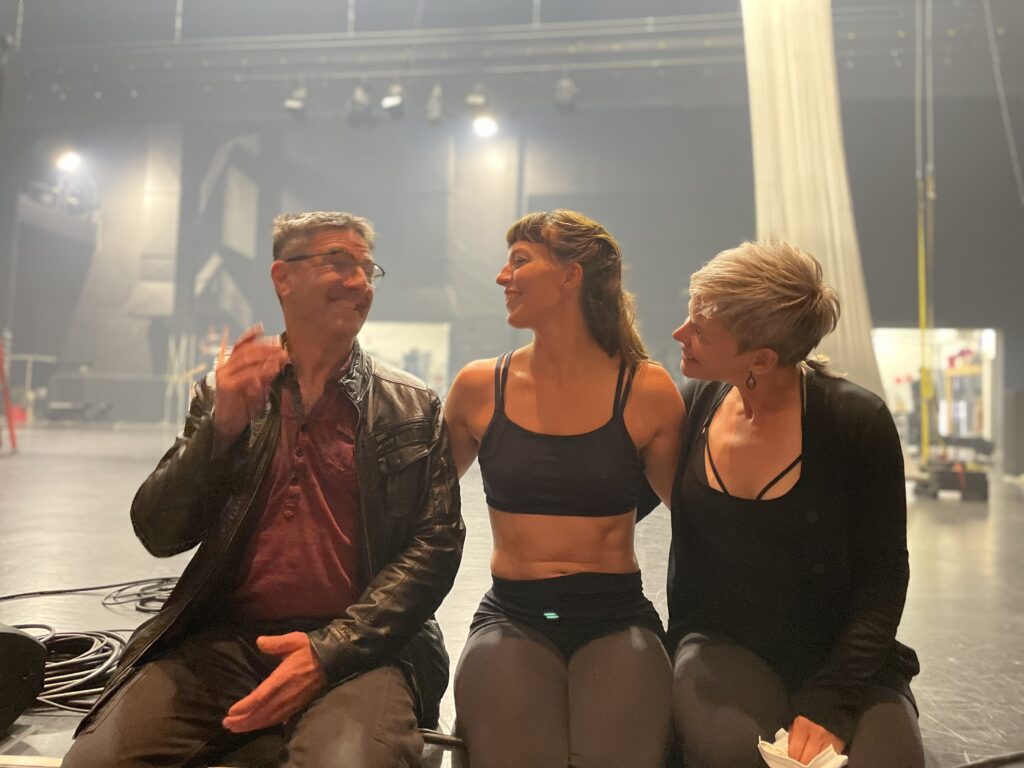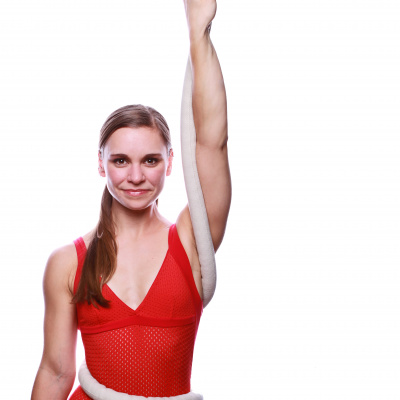Shadows and Tempests Bring a Woman’s Journey to Life in Anouk Vallée-Charest’s ‘Waves’
Framed by long brown hair, Anouk Vallée-Charest’s large, bright features beamed as we said hello. We have met to discuss her showWaves, a solo aerial and dance piece. This work was a long time coming. Vallée-Charest often thought, “One day when I feel ready, I’ll do my own show,” and admitted that even when the pandemic presented the perfect opportunity to bring this idea to life, “We never feel ready for it.”
A dancer and gymnast first, Vallée-Charest found circus to be a perfect meld of these disciplines. She attended Montreal’s École Nationale De Cirque excited for the opportunity to find expanded creativity in a physical career and train with an international cohort. As one of the youngest to attend the school at the time, she was inspired by the older performers. After school, she toured the world for twenty years performing on cruise ships, festivals, traditional and contemporary circus productions.

A robust career is an excellent foundation for a new creation project, but much support is always needed. Thankfully, Vallée-Charest was given free creation space (five different creation residencies in Montreal) in exchange for doing workshops. The project would have otherwise not been financially feasible. The show premiered in December 2021.
Waves is a 52 minute solo show–a physical challenge for anyone in any discipline, but especially hard for a circus artist. “I cannot do it two times per day. I cannot do it many times a week.” The intensity of the show has shaped how Vallée-Charest has been able to tour and perform it. “It was important for me to choose: I’ll do five theaters and then take a break.” The show is a combination of dance and aerial, and although one might assume the aerial work would be more exhausting, Vallée-Charest said the floorwork is fast and challenges her cardio. “At the end I’m exhausted, and then I need to do an aerial hoop act!” She admitted, “It’s a challenge, but that was part of the concept. This woman challenges herself, and pushes her limits, and keeps a force and determination to move forward and continue her journey.”
“Renaissance?” she asked me, clarifying a translation to English. Not the historical time period with the white wigs, we laughed. Instead: rebirth, recreation. “It is a rebirth of this woman and this artist. I really wanted to dive, and connect, and root back to my essence: a woman being on stage, just moving and being.” Vallée-Charest squeezed two fists close to her chest. And for the audience, “to see an artist breathing and witnessing emotion.” She continued, “It was this goal to reconnect and to take off the artifice, all the artificial parts.” Her hands expanded, wiping away the idea of makeup, and fanned toward the camera, shooing away anything unreal. “In circus, we are always pretty, and we make big costumes, and we want to shine, and all this. So it was really to come back to the essence. Just being a woman on stage and to present this human being on stage.”
Design elements support this goal. The show has a minimal lighting palette and Vallée-Charest wears a skin-toned costume. She clarified that minimalism does not mean the absence of action or intricacy, nor emptiness on stage. Detailed shadow work is used to shift audience perspective and to create the illusion of multiple people on stage at once. Apparatus are rearranged to create set pieces that hint at roads and pathways.
While the subject matter that sparkedWaves is personal to Vallée-Charest, the work is open enough that many people can identify with its themes. “I want people to dream in their head. They take their journey, and they dive into this show.” Vallée-Charest does not want to tell the audience what is happening, she would rather they let their imagination fill in the details.Waves includes one moment of text, Vallée-Charest said, a poem about planting the seeds of beauty, allowing it to flourish, and how we can believe in ourselves. “I wanted to let the people, the public, just imagine and have their beautiful moment [of] witnessing.”

At the core of the show is the ever-changing nature of life and how humans, and the woman portrayed inWaves, demonstrate resilience. “We tend to feel we need to be strong, and to never ‘drop the arm,’ and to always continue, and push, and fight, and not be weak. In life there’s ups and downs. The waves inspire me a lot–the ups and downs, the moving, the going, come back. It’s never fixed. The world is turning, the planet is turning, it’s always in movement. [As is] the road of this woman creating.”
Vallée-Charest said that audience members have noted “how this woman needs to fight sometimes and how she lets go at certain points.” They see the resilience she hopes to convey in her physical and inner strength while also recognizing her fragility. Vallée-Charest wanted to “play with the contrast of this strength and this vulnerability, the sensitivity that we have as a woman and all the emotion we can go through.”

We spoke about the creation ofWaves. Vallée-Charest described an incredibly smooth process of starting with some concepts and images, doing research and creation, and pieces of the show “just emerged” from there. She phrased it as the “magic of creation.” I noted that the space and time that she and her collaborators were granted were an important part of facilitating this magic. “It really takes time, and sometimes I feel we’re so busy that we don’t have enough time to just push like the creation and the exploration and to go to different universe, and different mode, and different road, that we are not used to. I think when we are rushed we go to the classic road we know. It’s really important and interesting to go out of your comfort zone. And from this is the beautiful part.” The creation process was in close collaboration with Lighting Designer, Stéphane Menigot, Co-Director Jennifer Lecuyer. Lucie Vignault was an additional choreographer, and Anomale couture contributed costume design.
“My goal was to meet my audience, to connect with them. I didn’t want them to feel like they were going to the cinema.” The audience is in close proximity to Vallée-Charest throughout the show. They hear her breathing during silent moments. “I think we need to feel these emotions in life. We stress in our life and we keep everything instead of just letting it out. And also the kids! I’m a big fan of kids–how we need to inspire them and tell them what’s possible. It was really inspiring to see girls and boys, they said to me, wow! They were amazed to open their brain and have the vision that life is open.”
WhileWaves feels like a far more gentle and open presentation of the female experience as compared to some other works that have been discussed in this series (I’m thinking specifically of the brash but jolly work by Yuck Circus), I still asked Vallée-Charest if she had experienced any pushback or negative reactions to the show. Because it was developed during Covid, she was very careful not to push people beyond certain limits. She created a work that satisfied her and was also sensitive to the cultural moment. The show has moments in which the character portrays fighting and is being challenge–Vallée-Charest described a tornado or a tempest that happens–but the audience is not confronted with concepts that leave them feeling uneasy. Now, I wish I had asked Vallée-Charest: would this work be different if it was not created during Covid and attuned to the fragility of that moment?
As Vallée-Charest spoke throughout our time together, I was drawn into the images: the shadows, fog, the apparatus creating set pieces. I just had to know: what was her favorite moment from the show? “There’s a moment when a piece of white silk is horizontal and I create shadow with it. I appear, and as I’m coming in, there are two Anouks appearing, and then I go out and then I disappear and then I come back. This moment is very fragile for me and even mystical a little bit because they [the audience],” she peered through two vertical hands shifting her head side to side noting the audience’s potential confusion about what is happening at that moment. “I decide if I want to go faster or slow, so I can make it a moment of suspension, really magical.”
We ended by speaking about how it is rare to see a solo circus show by a woman. Vallée-Charest listed a few other people she knew of creating work, but she believed that her show is possibly the only one on the Quebec market at the moment. From a commercial and capitalistic viewpoint, she’s got a monopoly, but Vallée-Charest doesn’t see it that way. She said that her work is a way to open doors for others to do the same. We fell just a bit into the rabbit hole of grants, funding, and how other women might find financial support to create a solo show, but Vallée-Charest’s advice was, “Just start! It might take some time, and it may be slow, but just start! I think it’s important that people continue to express, and that we hear [different] voices; that people really trust in themselves, and they are not afraid, and they’re not scared of creating.” Her advice is to “take off the judgment part, and just glide. Try not to think too much: what people will think? It’s important that we hear a lot of different colors– it’s a metaphor–of all the different ideas people can create, versatility, different styles. That’s what is really important, and interesting, and rich in our industry.”
At this time, there are no upcoming performances of Waves. Vallée-Charest is touring with other acts for the time being. For more information about the production and to keep an eye out for future performance dates please visithttp://anoukvallee-charest.com/en/.
Main image: Photo by Sébastien Lozé...
Do you have a story to share? Submit your news story, article or press release.





